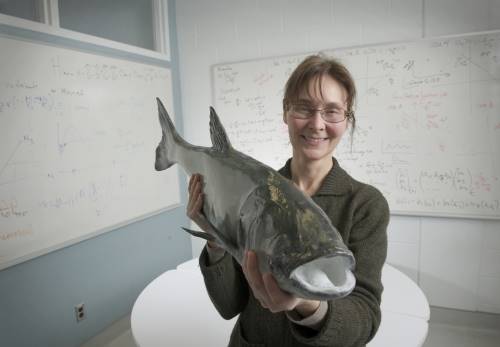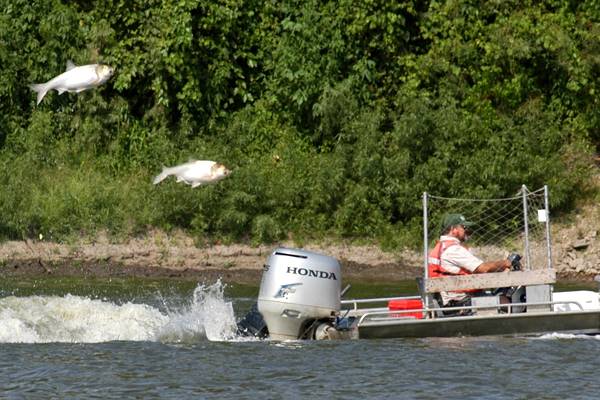Landmarking Study Sheds Light On Managing Asian Carp Invasion Risk
In ecology, “landmarking” is defined as the tendency of insects and animals to congregate in locations that make it easier for them to find mates. The sites that they flock to are typically easy to find and special — that is, there aren’t many sites like them elsewhere in the ecosystem.
For insects like butterflies, landmarking is showcased through their flights to the tops of trees or mountains where they can be more easily spotted by members of the opposite sex. Humans are said to be landmarking when they go to bars or other social venues where high numbers of potential mates will be present. Fish, in spite of swimming around in waters that look similar, do it too, by keying in on water flows and temperatures only they can sense.
Landmarking itself isn’t a problem, as it is practiced naturally by creatures every day. But invasive species like Asian carp, which can use landmarking to spread to new areas, are concerning. That said, knowledge of landmarking can be useful in minimizing their spread, as a study by scientists at the University of Waterloo and Fisheries and Oceans Canada suggests.
“They’re (Asian carp) attracted to large, fast-flowing, warm rivers,” said Kim Cuddington, professor of ecology at the university and lead author of the study published in the journal Theoretical Ecology. “And that water signal goes out far into lakes.”
So those are the conditions that carp look for when it’s time to breed. How can that knowledge be used to limit their incursion into the Great Lakes? Well, going somewhat against an understandable assumption, instead of limiting the number of areas that they would like to use, it would be more effective to expand the sites available to them.

Kim Cuddington. (Credit: Martin Schwalbe)
If that’s a little hard to believe, Cuddington has proved it, using a branch of mathematics called combinatorics. The branch is known to have developed the birthday problem, which helps to explain the findings on Asian carp landmarking. The birthday problem looks to find how many people are needed in a room until two of them will have the same birthday.
“The number is actually quite small. You only need 23 people,” said Cuddington. “Essentially we’re looking at the same problem (with Asian carp), except we have males and females.”
With that sort of approach in mind, Cuddington worked with Warren Currie and Marten Koops, both of Fisheries and Oceans Canada, to model issues surrounding Asian carp knocking on the doorways of rivers flowing into the Great Lakes.
The study’s findings suggest that the number of individual sites needed for a male and female to meet up can be quite small, says Cuddington, and it all has to do with probability. As the number of sites go up, the odds that the fish will meet go down, whereas the reverse is true if the sites become harder to find.
“People have been saying that there’s only a few rivers through which carp could make it in and that makes invasion quite unlikely. But the opposite is actually true,” said Cuddington. “Because there are fewer places they can go, it increases the probability they will find a mate.”

Asian carp are fast-growing and aggressive, making them a threat to native Great Lakes species. (Credit: USGS)
One of the goals for those working to manage the risk of Asian carp invasion in the Great Lakes is determining how leaky the barriers could be and still be able to keep them out, says Cuddington. “They can’t be very leaky at all,” she said.
Because of her knowledge of math, including the birthday problem, Cuddington says she wasn’t surprised by the information that the modeling work yielded. But for others who may have not considered the role of landmarking, the study illuminates a new way to think about approaching and managing the risk of Asian carp invasion.
She hopes the results can be employed to help, and points out a recent discovery of two male grass carp in Lake Ontario. According to the Toronto Star, both fish were fertile and found in contained ponds in Tommy Thompson Park in late July. Following their discovery, biologists with Fisheries and Oceans Canada acted swiftly, removed them from the water and killed them. The two fish will be sent to the United States for further examination.
The findings could also be applied in helping endangered species. “So if you have small populations, maybe you don’t want to create habitat. It’s really a kind of tricky thing,” said Cuddington. “For what reason are they endangered? Would they be more at risk? And what’s the end objective? There’s something non-intuitive about this that creating a bunch of new habitat might not be the best method.”



0 comments